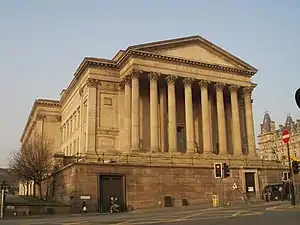William Grinsell Nicholl
William Grinsell Nicholl (1796–1871) was a 19th-century British architectural and monumental sculptor.

The Fitzwilliam Museum

The Oxford and Cambridge Club

St Georges Hall, Liverpool, from the southwest
.jpg.webp)
WIlliam Grinsell Nicholl. Date and photographer unknown
Life
He was born in Marylebone, London in 1796. In 1822 he attended the Royal Academy Schools.[1]
He exhibited in the Royal Academy from 1822 to 1861 and was highly respected. His studio was on Grafton Street East - off Totteham Court Road, London
Architectural Works
- London Customs House (1827) - entablature as part of rebuilding after partial collapse
- Portico and columns of the Fitzwilliam Museum, Cambridge (1830-1837) - under George Basevi and designed by Charles Lock Eastlake
- Bas-reliefs over windows at the Oxford and Cambridge Club in London (1838) - under Sir Robert Smirke
- Four lions at foot of stairs, Fitzwilliam Museum (1839)[3]
- Pediment of the Taylor Institute in Oxford (1846)[4]
- Pediment and columns of St George's Hall, Liverpool (1850) - under Charles Robert Cockerell
- Four lions at St George's Hall, Liverpool (1855)[5]
- Reredos at Waltham Abbey Church (1862)[6] under William Burges
- Lectern at Worcester College Chapel, Oxford University (1866)
Other Works
- Bust of Henry Sass (1820) -possibly as Nicholl's tutor
- Bust of George III (c.1822) copy of Jubilee Bust by Peter Turnerelli[7]
- Bust of John Law, Archdeacon of Rochester (1827), Chatham Parish Church[8]
- Bust of Philip Rundell (1827) now in Victoria and Albert Museum[9]
- Statue of Captain Cook (1844) Royal Academy
- Statue of Lord Cornwallis (1867), India Office
- Statue of Clive (1867) India Office
- Monument to Sir John Hippisley (1825) Temple Church, Inner Temple, London
- Monument to John Frewen-Turner (1829) Cold Overton, Leicestershire
- Monument to Henry Wootton (1830) at Minster, Kent
- Monument to Sir George Don (1832) originally in Garrison Church, Gibraltar, now in the Gibraltar Parliament
- Monument to Joseph Bonsor (1835) Great Bookham, Surrey
- Monument to Elizabeth Morley (1837) Walthamstow Parish Church[10]
- Monument to Richard Stevenson (MP) (1837) Trinity College Chapel, Cambridge
- Monument to Rev J. Murray (1862) St Andrews Church, Wells Street, London
Family
He married Emma Elizabeth Nicholson in Paddington in 1821.
References
- https://sculpture.gla.ac.uk/view/person.php?id=msib5_1246023398
- Dictionary of British Sculptors 1660-1851 by Rupert Gunnis
- Architectural History of Cambridgevol3 p.210
- Builder (journal) 1846 p.505
- https://www.liverpoolecho.co.uk/whats-on/whats-on-news/31-liverpool-statues-true-stories-16523938
- Builder (journal) 1862 p.499
- http://www.historicalportraits.com/Gallery.asp?Page=Item&ItemID=1251&Desc=King-George-III-%7C-William-Grinsell-Nicholl
- http://www.speel.me.uk/sculpt/nicholl.htm
- http://collections.vam.ac.uk/item/O75477/philip-rundell-1743-1827-bust-nicholl-william-grinsell/
- https://www.british-history.ac.uk/vch/essex/vol6/pp285-294
This article is issued from Wikipedia. The text is licensed under Creative Commons - Attribution - Sharealike. Additional terms may apply for the media files.